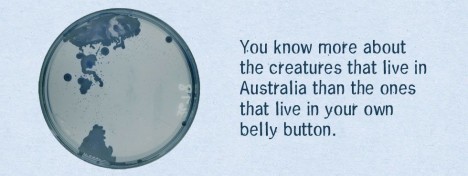Our own body is covered with entire (albeit tiny) ecosystems. Incredible numbers of bacterial strains live in and on the human body. And the belly button seems to be a place extraordinarily rich in bacterial passengers. The Belly Button Biodiversity Project took samples from the navels of volunteers and went to work, performing DNA analysis on the bacteria that were found there.

(Source: Belly Button Biodiversity Project)
So far, 95 samples have been analyzed, and these have revealed an amazing diversity. Over 1400 bacterial strains have already been analyzed, of which 662 couldn’t even be identified on family level, strongly suggesting they might be new to science. The project, originally intended as fun science communication project, is rapidly making contributions to our (fairly limited, so it seems) understanding of bacterial diversity.
The identification of the bacteria takes place through the gene for the 16S ribosomal subunit, which is widely used in studies of bacterial diversity. The results appear to confront us with our limited understanding of how many bacteria there actually are, including on and in our own bodies. Of course, it should be noted that belly buttons are scarcely the most sampled ‘habitat’.
Despite the very high number of strains analyzed so far, there seems to be a ‘core biome’of about 40 species that account for about 80 percent of the bacterial populations of our belly button biology.




Comments